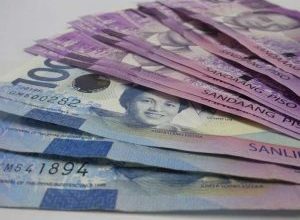NCR’s economic output rebounds but still below pre-pandemic level

A vendor arranges eggs at the Paco public market in Manila. — PHILIPPINE STAR/ RUSSELL PALMA
By Bernadette Therese M. Gadon, Researcher
THE NATIONAL Capital Region’s (NCR) economy bounced back last year from a double-digit contraction in 2020, but remained below the national growth rate due to strict lockdowns meant to contain the coronavirus.
Preliminary results from the latest regional accounts released by the Philippine Statistics Authority (PSA) showed NCR’s economic output expanded by 4.4% last year, reversing the 10% drop in 2020. However, this was still lower than the 7% growth in 2019.
Metro Manila’s growth was also well below the Philippines’ revised 5.7% economic growth last year.
NCR’s growth was the third slowest among the 17 regions in the country, only ahead of Bicol (4.3% in 2021 from -8.3% in 2020) and Mimaropa Region (3.3% from -7.5%).
Other regions that missed the national average last year were Central Visayas (5.4%), Soccsksargen (5.2%), Cagayan Valley (5.1%), and the Ilocos Region (4.6%).
Calabarzon had the fastest growth rate among the 17 regions with 7.6%, a turnaround from 10.5% decline in 2020. It was followed by the Bangsamoro Autonomous Region in Muslim Mindanao (7.5% from -1.9%), Cordillera Administrative Region (7.5% from -10.2%), and Central Luzon (7.4% from -13.9%).
Still, NCR remained the largest contributor to national economic output last year with a 31.5% share, slightly lower than 31.9% in 2020. This was followed by Calabarzon with a 14.7% share, Central Luzon with 10.9%, and Central Visayas with 6.5%.
PSA-NCR Regional Director Paciano B. Dizon said the capital region grew slower than other regions in 2021 due to strict lockdowns amid the COVID-19 outbreak.
“If you will differentiate some of the regions and cities, mas marami talagang lockdowns sa NCR [last year] (there were a number of lockdowns in NCR last year). So that’s a contributor to the slow growth rate of NCR in comparison to other regions,” Mr. Dizon told a press briefing in Quezon City on Thursday.
Metro Manila was placed under varying degrees of lockdowns last year. The strictest form of lockdown was implemented in April and August as COVID-19 infections surged.
The government only shifted to an alert level system with granular lockdowns in the fourth quarter, with restrictions further loosened in November and December.
Aside from the mobility curbs, economists said Metro Manila’s growth last year was due to base effects coming from the contraction in the previous year and the gradual reopening of the economy.
“The interruptions in economic reopening might have contributed to slower growth unlike in other regions where restrictions and new policies are quite predictable unlike in NCR,” Asian Institute of Management economist John Paolo R. Rivera said in an e-mail.
ING Bank N.V. Manila Branch Senior Economist Nicholas Antonio T. Mapa noted that NCR’s growth was one of the slowest due to the stricter lockdowns and high number of cases.
“Thus, it’s clear that economic recovery and public health go hand in hand,” he said in a separate e-mail. “Base effects and the reopening may have driven the pickup in transport and storage while mining and quarrying may have benefited from the presidential decision to allow new mining agreements.”
In terms of sectoral output, Caraga led the regions in the service sector with an 8.1% increase last year, reversing a 5.3% drop in 2020. Soccsksargen and BARMM trailed with 6.7% (from -8.9%) and 6.6% (from -4.5%), respectively.
By industry, CAR grew by 16.3% (from -13.7%), followed by Central Luzon (13.8% from -19.9%) and Calabarzon (11.2% from -12.6%).
BARMM had the fastest growth among the regions in the agriculture sector with 8.3% (from 2.7%), followed by Central Visayas (5.6% from 4.2%) and NCR (5.5% from -3.3%).
On the expenditure side, Caraga recorded the quickest pace in household spending with 10.6%, a reversal of the 7.8% contraction in 2020. It was followed by Eastern Visayas (10.2% from -7.9%) and Cagayan Valley (9% from -8.4%).
The pace of government spending was fastest in BARMM with 12.6% (from 11.3%), followed by Cagayan Valley with 11.6% (from 8.8%) and Central Luzon with 8.9% (from 9.1%).
BARMM had the fastest growth in gross capital formation, the investment component of the economy, with 93.9% (from -50.1%), followed by Calabarzon (46.4% from -53.9%) and Central Luzon (42.6% from -46.3%).
NCR and Eastern Visayas recorded the highest export of goods and services to the rest of the world last year at 12.3%, after double-digit contractions in 2020.
Meanwhile, BARMM’s imports surged by 100.9%, a reversal of the -26.9% seen in 2020. Imports of Western Visayas and Northern Mindanao grew by 27.2% (from -17.5%) and 17% (from -12%), respectively.
On a per-capita basis, Metro Manila led the regions with P418,530 at constant 2018 prices, up by 3.2% — a turnaround from -11.1% in 2020. However, this was still below the 5.6% growth in 2019.
This year, analysts expect much faster economic growth as COVID-19 cases decline and restrictions ease.
“Assuming no other disruptions happen due to pandemic or other factors, it should continue to grow at a faster rate. No exact figure for now but the trajectory is promising,” Mr. Rivera said.
The government is targeting 7-9% gross domestic product (GDP) expansion this year.
Mr. Mapa said consumer spending, particularly for leisure, dining and recreational activities are likely to “improve dramatically” thanks to more relaxed lockdown levels.
Metro Manila and most parts of the country are under the most lenient alert level.
“It is imperative for authorities to ensure the economy can remain as open as possible, however always mindful to ensure support for the public healthcare sector,” he added.
Security Bank Corp. Chief Economist Robert Dan J. Roces said any renewed lockdowns this year could delay economic recovery.
“Risks remain as to further outbreaks given that we remain in a pandemic, notably lockdowns being experienced by some major Asian [cities], although the vaccination level in the capital is encouraging and could hopefully be enough to prevent case spikes and sustain the reopening,” he said in a separate e-mail.
“Another major risk is inflation due to the conflict between Russia and Ukraine, with commodity prices spiking and causing capital goods to become pricier and thereby possibly slow down productivity,” he added.




